Over the past 10-15 years, we have seen significant advances in the working width of farm machinery and the technology associated with it.
The move to bigger tractors, maximising output capacity in restricted weather windows and the increasing shortage of skilled labour have been the major drivers.
Whether you’re farming or contracting, regardless of the scale, the efficiency of any business is key to its success.
This week, we travelled to a large farm in Tipperary (whose owners wish to remain unnamed) to catch up with a recently purchased 12-furrow Kverneland wagon plough in action. This is the largest plough in Ireland, and the largest plough Kverneland offers.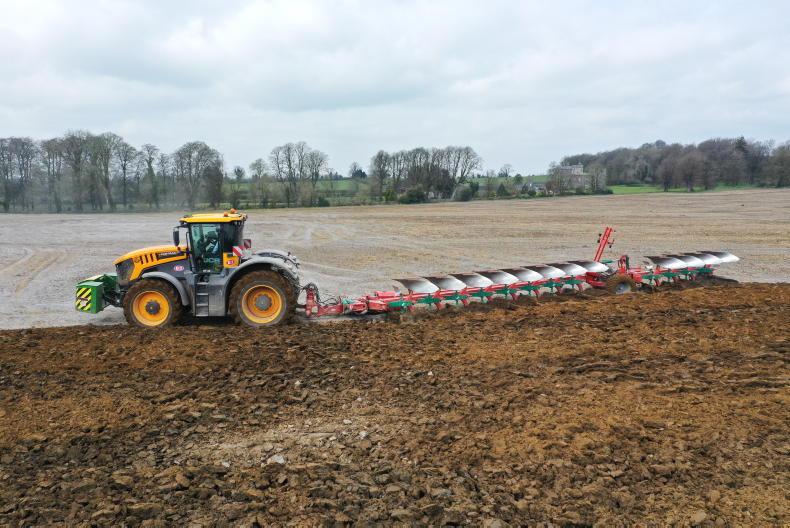
The wagon plough can be split to work as a semi-mounted eight-furrow and a typical four-furrow mounted reversible plough.
Why such a big plough?
“We typically use six-furrow reversible ploughs which run on 200hp tractors. When running two of these ploughs together, we found that there was a lot of time lost waiting on the headlands. Ideally, you want the ploughing to match up and skilled labour is a challenge. It’s getting harder and harder to find good ploughmen nowadays. With the 12-furrow plough on the 335hp Fastrac in a big field, one good ploughman can cover the same area as two, meaning we are saving a lot on fuel and freeing up a skilled operator and tractor for other work.
“Depending on the year, we plough one-third to half of the farm. Last year, we invested in an articulated John Deere 9RX (600hp) tractor. Although largely used for min-till operations, it can be used to plough ground in wetter years, when we aren’t doing as much min-till work and if the Fastrac is coming under pressure.
“In terms of brand selection, we went with Kverneland as they were the only manufacturer that could offer us a split plough of such a size. If the going gets tough in a bad year, we can essentially split the wagon plough three ways. We can use it as two ploughs, in the form of an eight-furrow and four-furrow, or in its current state as a 12-furrow machine,” said the farm manager. 
The plough features a stepless vari-width system for infinite adjustments of its working width from the driver’s seat on the move.
The machine
As outlined above, the plough features a three-in-one concept. Depending on the conditions, the wagon plough can be split to work as a semi-mounted eight-furrow and a typical four-furrow mounted reversible plough, the same as an EG 200. The manufacturer says the rear plough can be coupled or uncoupled within a few minutes.
Kverneland says a non-heat-treated part is a weak part, and thus claims to heat treat its frames by induction twice. The company says this gives them three times as much strength. The manufacturer supplies its frames as one sole part, with no welding. This particular PW plough featured has a 200x200mm frame.
The plough features Kverneland’s stepless vari-width system for infinite adjustments of its working width. This system is available either with hydraulic or mechanical furrow adjustments, helping the operator choose the best balance between tractor capacity and the soil conditions on the day. The hydraulic variant allows adjustments of the furrow width from the driver’s seat on the move.
Kverneland’s automatic auto-reset design features a multi-leaf spring system, designed to allow the plough legs to release over stones and other solid objects, before returning to the set ploughing depth. The standard auto-reset system features seven heat treated springs.
The farm runs the plough on number 28 mouldboards, otherwise known as the ‘wide tyre body’. This is designed to handle tractor wheels up to 710mm, suitable to plough to a depth of 15-30cm (6-12in) and 30-55cm (12-22in) wide. The plough can be set up to either plough in-furrow or on-land. Kverneland says that in Ireland, approximately 90% of the ploughs it sells have mouldboards, with the remaining 10% slatted. 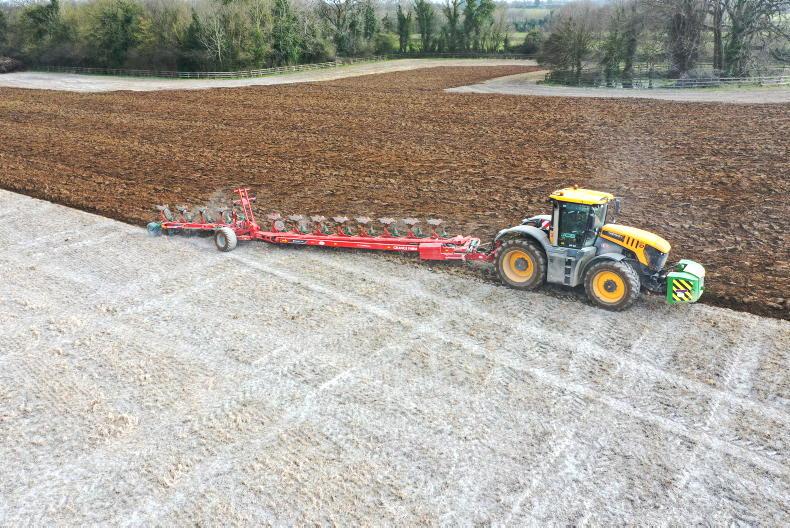
The farm run the plough on number 28 mouldboards, suitable to plough to a depth of 15 to 30cm (6 to 12”) and 30 to 55cm (12 to 22”) wide.
In the cab
The PW plough comes with an advanced management system. In the cab, the operator can choose between Automatic Turning Sequence (ATS) control with an Isobus compatible option, manual management with the addition of a valve controller or manual management via tractor control.
When equipped with the ATS system, the plough will go through the headland lifting and reversing sequence with several clicks of a button. Meanwhile, the rear four-furrow plough section is equipped with a hydraulic toplink, meaning it’s held in a raised position during the turning phase.
In this case, the plough is running on Isobus through the tractor’s terminal. The plough functions can be altered through the screen, but the operator has fitted an Isobus joystick, where he controls all functions with the press of a button. 
The plough is running on Isobus through the tractor’s terminal, and through the Isobus joystick, with plough functions able to be altered through both.
Press
The farm often runs the two integrated Packomat presses on the plough. These enable reconsolidation of the soil, and essentially mean two operations are covered in one pass.
“The Packomat presses are a great job. It works a treat in good conditions, but it can be challenging in wetter conditions. The ground we are ploughing today is a little on the heavier side, and thus why its not being used. Ground that gets a run of the press is far easier to work with, and often only needs one run of the powerharrow before sowing,” explained the farm manager.
Kverneland claims that the press contributes to the balance of the plough in work, meaning no extra pulling forces are needed, something the farm manager agreed with. 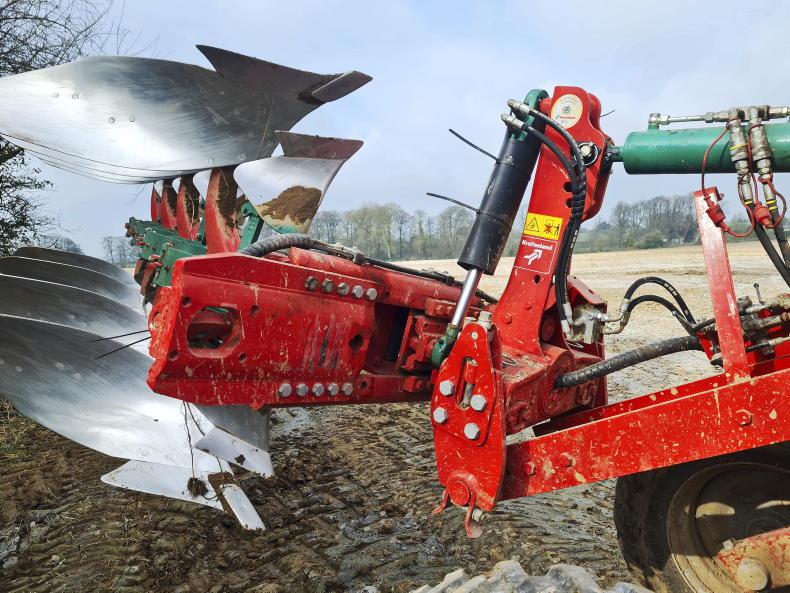
The manufacturer says the rear plough can be coupled or uncoupled within a few minutes.
Driver comment
Starting off on a Ford 5000 and a four-furrow, the machine driver has notched 42 years’ experience ploughing under his belt.
“I really like it. In big fields, it’s very easy to plough with and despite its size, it does lovely ploughing. Due to its size, you have to leave a big headland for it to turn. When turning on the headland, depending on the field I typically follow an ‘S’ pattern. Ploughing tight to the headlands can be tricky, as it’s hard to get in close to ditches and corners etc, but we often plough the headlands with a smaller plough to avoid this. The only issue I have with it is its sheer size on the road. It’s very long and takes minding on narrow roads, and you won’t get it in every gate with it.
“In terms of operating, it’s very straightforward. All controls are to hand on the Isobus joystick. As regards maintenance, I grease it every second day, and change the tips after every 150-200 acres, much the same as with any plough. The 335hp Fastrac is handling it very well to date, averaging out at a forward speed of around 7.5km/h. The tractor has a 600l fuel tank and will burn the most of it on a long day’s ploughing”, he explained.
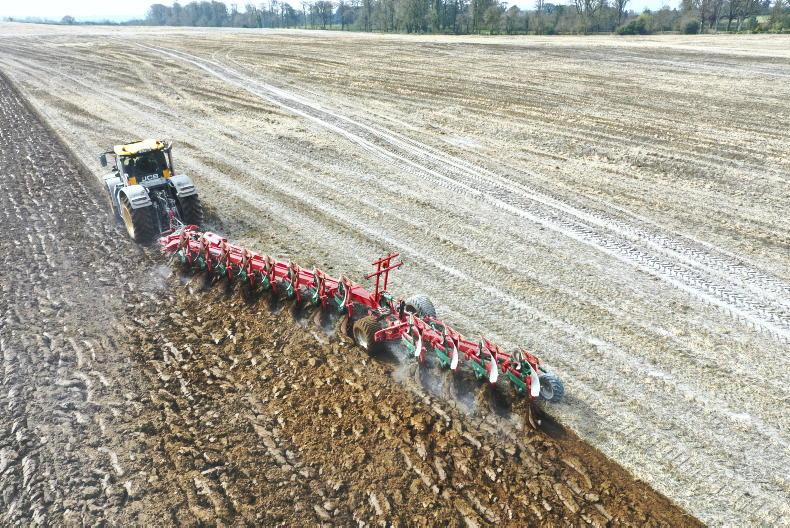
The plough has a list price of €100,000 plus VAT.
“We took delivery of the 12-furrow Kverneland wagon plough in September 2021 and have put somewhere in the region of 700 plus acres through it to date. It has worked out very well for us. Mechanically, it hasn’t caused any grief and we find it easy to operate.
“The JCB Fastrac 8330 has handled it well, and has proved well capable of pulling it. Now it’s worth noting that the weather last autumn and this spring has been exceptional for carrying out field work. We plough the smaller fields and the outer headlands with smaller ploughs. We only use the 12-furrow in 30 acre plus fields.
“In the right fields and ideal conditions, the outfit would turn in the region of 80 acres per day. I suppose our average to date is around 60 acres/day. Typically, we always ran three ploughs. The move to this large Kverneland wagon plough has allowed us to get through the same work with two ploughs, meaning we can use that other tractor and skilled labour unit at other cultivating or seeding works.”
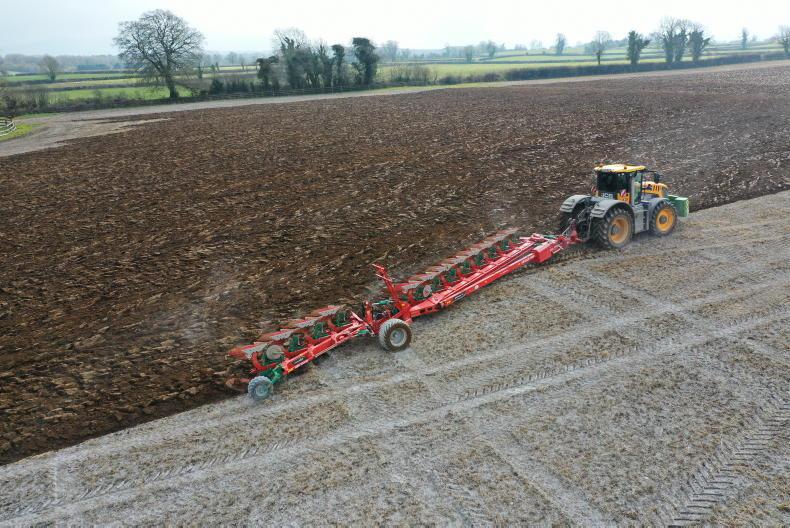
"In the right fields and ideal conditions, the outfit would turn in the region of 80 acres per day. I suppose our average to date is around 60 acres/day".
Model: PW.
Number of furrows: 12.
Interbody clearance: 100cm.
Underbeam clearance: 70/75cm.
Furrow width: 35-50cm.
Plough list price (with Packomat): €185,000 plus VAT.
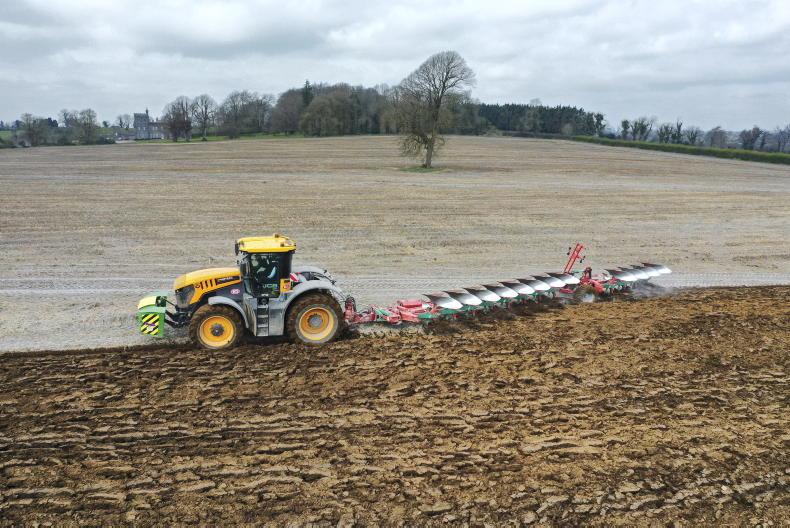
"The 335hp Fastrac is handling it very well to date, averaging out at a forward speed of around 7.5km/h".
Over the past 10-15 years, we have seen significant advances in the working width of farm machinery and the technology associated with it.
The move to bigger tractors, maximising output capacity in restricted weather windows and the increasing shortage of skilled labour have been the major drivers.
Whether you’re farming or contracting, regardless of the scale, the efficiency of any business is key to its success.
This week, we travelled to a large farm in Tipperary (whose owners wish to remain unnamed) to catch up with a recently purchased 12-furrow Kverneland wagon plough in action. This is the largest plough in Ireland, and the largest plough Kverneland offers.
The wagon plough can be split to work as a semi-mounted eight-furrow and a typical four-furrow mounted reversible plough.
Why such a big plough?
“We typically use six-furrow reversible ploughs which run on 200hp tractors. When running two of these ploughs together, we found that there was a lot of time lost waiting on the headlands. Ideally, you want the ploughing to match up and skilled labour is a challenge. It’s getting harder and harder to find good ploughmen nowadays. With the 12-furrow plough on the 335hp Fastrac in a big field, one good ploughman can cover the same area as two, meaning we are saving a lot on fuel and freeing up a skilled operator and tractor for other work.
“Depending on the year, we plough one-third to half of the farm. Last year, we invested in an articulated John Deere 9RX (600hp) tractor. Although largely used for min-till operations, it can be used to plough ground in wetter years, when we aren’t doing as much min-till work and if the Fastrac is coming under pressure.
“In terms of brand selection, we went with Kverneland as they were the only manufacturer that could offer us a split plough of such a size. If the going gets tough in a bad year, we can essentially split the wagon plough three ways. We can use it as two ploughs, in the form of an eight-furrow and four-furrow, or in its current state as a 12-furrow machine,” said the farm manager. 
The plough features a stepless vari-width system for infinite adjustments of its working width from the driver’s seat on the move.
The machine
As outlined above, the plough features a three-in-one concept. Depending on the conditions, the wagon plough can be split to work as a semi-mounted eight-furrow and a typical four-furrow mounted reversible plough, the same as an EG 200. The manufacturer says the rear plough can be coupled or uncoupled within a few minutes.
Kverneland says a non-heat-treated part is a weak part, and thus claims to heat treat its frames by induction twice. The company says this gives them three times as much strength. The manufacturer supplies its frames as one sole part, with no welding. This particular PW plough featured has a 200x200mm frame.
The plough features Kverneland’s stepless vari-width system for infinite adjustments of its working width. This system is available either with hydraulic or mechanical furrow adjustments, helping the operator choose the best balance between tractor capacity and the soil conditions on the day. The hydraulic variant allows adjustments of the furrow width from the driver’s seat on the move.
Kverneland’s automatic auto-reset design features a multi-leaf spring system, designed to allow the plough legs to release over stones and other solid objects, before returning to the set ploughing depth. The standard auto-reset system features seven heat treated springs.
The farm runs the plough on number 28 mouldboards, otherwise known as the ‘wide tyre body’. This is designed to handle tractor wheels up to 710mm, suitable to plough to a depth of 15-30cm (6-12in) and 30-55cm (12-22in) wide. The plough can be set up to either plough in-furrow or on-land. Kverneland says that in Ireland, approximately 90% of the ploughs it sells have mouldboards, with the remaining 10% slatted. 
The farm run the plough on number 28 mouldboards, suitable to plough to a depth of 15 to 30cm (6 to 12”) and 30 to 55cm (12 to 22”) wide.
In the cab
The PW plough comes with an advanced management system. In the cab, the operator can choose between Automatic Turning Sequence (ATS) control with an Isobus compatible option, manual management with the addition of a valve controller or manual management via tractor control.
When equipped with the ATS system, the plough will go through the headland lifting and reversing sequence with several clicks of a button. Meanwhile, the rear four-furrow plough section is equipped with a hydraulic toplink, meaning it’s held in a raised position during the turning phase.
In this case, the plough is running on Isobus through the tractor’s terminal. The plough functions can be altered through the screen, but the operator has fitted an Isobus joystick, where he controls all functions with the press of a button. 
The plough is running on Isobus through the tractor’s terminal, and through the Isobus joystick, with plough functions able to be altered through both.
Press
The farm often runs the two integrated Packomat presses on the plough. These enable reconsolidation of the soil, and essentially mean two operations are covered in one pass.
“The Packomat presses are a great job. It works a treat in good conditions, but it can be challenging in wetter conditions. The ground we are ploughing today is a little on the heavier side, and thus why its not being used. Ground that gets a run of the press is far easier to work with, and often only needs one run of the powerharrow before sowing,” explained the farm manager.
Kverneland claims that the press contributes to the balance of the plough in work, meaning no extra pulling forces are needed, something the farm manager agreed with. 
The manufacturer says the rear plough can be coupled or uncoupled within a few minutes.
Driver comment
Starting off on a Ford 5000 and a four-furrow, the machine driver has notched 42 years’ experience ploughing under his belt.
“I really like it. In big fields, it’s very easy to plough with and despite its size, it does lovely ploughing. Due to its size, you have to leave a big headland for it to turn. When turning on the headland, depending on the field I typically follow an ‘S’ pattern. Ploughing tight to the headlands can be tricky, as it’s hard to get in close to ditches and corners etc, but we often plough the headlands with a smaller plough to avoid this. The only issue I have with it is its sheer size on the road. It’s very long and takes minding on narrow roads, and you won’t get it in every gate with it.
“In terms of operating, it’s very straightforward. All controls are to hand on the Isobus joystick. As regards maintenance, I grease it every second day, and change the tips after every 150-200 acres, much the same as with any plough. The 335hp Fastrac is handling it very well to date, averaging out at a forward speed of around 7.5km/h. The tractor has a 600l fuel tank and will burn the most of it on a long day’s ploughing”, he explained.

The plough has a list price of €100,000 plus VAT.
“We took delivery of the 12-furrow Kverneland wagon plough in September 2021 and have put somewhere in the region of 700 plus acres through it to date. It has worked out very well for us. Mechanically, it hasn’t caused any grief and we find it easy to operate.
“The JCB Fastrac 8330 has handled it well, and has proved well capable of pulling it. Now it’s worth noting that the weather last autumn and this spring has been exceptional for carrying out field work. We plough the smaller fields and the outer headlands with smaller ploughs. We only use the 12-furrow in 30 acre plus fields.
“In the right fields and ideal conditions, the outfit would turn in the region of 80 acres per day. I suppose our average to date is around 60 acres/day. Typically, we always ran three ploughs. The move to this large Kverneland wagon plough has allowed us to get through the same work with two ploughs, meaning we can use that other tractor and skilled labour unit at other cultivating or seeding works.”

"In the right fields and ideal conditions, the outfit would turn in the region of 80 acres per day. I suppose our average to date is around 60 acres/day".
Model: PW.
Number of furrows: 12.
Interbody clearance: 100cm.
Underbeam clearance: 70/75cm.
Furrow width: 35-50cm.
Plough list price (with Packomat): €185,000 plus VAT.

"The 335hp Fastrac is handling it very well to date, averaging out at a forward speed of around 7.5km/h".














 This is a subscriber-only article
This is a subscriber-only article





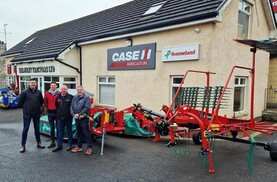



SHARING OPTIONS: